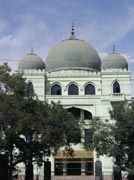|
The distribution structure of "great scattering and small concentration"
"Great scattering and small concentration" is the distinctive character of the distribution of the Hui nationality. This character was shown when the aboriginal guests came from the east and the Huis immigrated from the east. By the Yuan, Ming and Qing dynasties, with the Huis soldiers' opening up wasteland and growing food grain, the trade contact of merchants, the wandering of officials and scholars and the preaching activities of religious circles, this state became more obvious. Additionally, because of the discrimination and oppression of feudal ruling classes, especially the brutal suppression and crazy slaughter of the royal government of the Qing dynasty to the Huis people in quick succession, thousands of people of the Hui nationality in northwestern and southwestern regions were forced to flee from home and lead wretched lives, which intensified the formation of this kind of structure. After the founding of the new China, tens of thousands of sons and daughters of the Hui nationality joined in army or were admitted to various kinds of colleges and universities in succession. After transferred to civilian work or graduation, they were distributed to all places throughout the country to work, which made the distribution of the Hui nationality vaster. According to the statistics of the national census in 1990, the total population of the Hui nationality was 8,602,978; they are distributed in most of the counties and cities throughout the country. Except the Han nationality, she is the nationality that distributes the widest.
 Even though, the Hui nationality still has her own relatively concentrated inhabiting regions, which are southeastern regions and Yunnan, and so on. In other regions, though the inhabitance of the Hui nationality is scattered, people pursue small concentration in the objective situation of great scattering. So, in all the places where there lives the Hui nationality, either in cities and towns or villages, there always are some tracts of communities concentrating in certain areas, streets, villages or stockade villages, there seldom are the sole villages of the Hui nationality. Additionally, most of them are distributed on the communication lines or near them in order to keep contact with the adjacent regions. Because only by small concentration, can they keep in touch with each other, have social intercourse and contact with each other and help each other, and united each other to defend from humiliation; only by small concentration can they conveniently intermarry and hold funerals; only by small concentration can they have the ability to build temples, be at church and recite scriptures. In a word, the small concentration of "living surrounding the temples" makes the people of the Hui nationality which are in great scattered state keep close social contact, and develop integrated and normal religious activities. The small concentration helps the Huis people to gradually develop and expand as a branch of important strength of Chinese nation, but not swallowed and neglected during the wind and rain experiences of six to sever hundred years. Even though, the Hui nationality still has her own relatively concentrated inhabiting regions, which are southeastern regions and Yunnan, and so on. In other regions, though the inhabitance of the Hui nationality is scattered, people pursue small concentration in the objective situation of great scattering. So, in all the places where there lives the Hui nationality, either in cities and towns or villages, there always are some tracts of communities concentrating in certain areas, streets, villages or stockade villages, there seldom are the sole villages of the Hui nationality. Additionally, most of them are distributed on the communication lines or near them in order to keep contact with the adjacent regions. Because only by small concentration, can they keep in touch with each other, have social intercourse and contact with each other and help each other, and united each other to defend from humiliation; only by small concentration can they conveniently intermarry and hold funerals; only by small concentration can they have the ability to build temples, be at church and recite scriptures. In a word, the small concentration of "living surrounding the temples" makes the people of the Hui nationality which are in great scattered state keep close social contact, and develop integrated and normal religious activities. The small concentration helps the Huis people to gradually develop and expand as a branch of important strength of Chinese nation, but not swallowed and neglected during the wind and rain experiences of six to sever hundred years.
After the founding of the P.R.C, to practically guarantee that the people of Hui nationality can exercise the right of being their own master as other nationalities, the party and state have established the Ningxia Hui Autonomous Region, Gansu Linxia Hui Autonomous Prefecture, etc over ten national autonomous regions, and some other cultural, educational and administrative institutions, let the scattered Huis people throughout the country share the sunshine, rain and dew of national policies, and feel the warmth of the great national family.
Islam---the tie of forming the Hui nationality <<
The commercial culture enjoying good fame at all times and in all lands >>
|